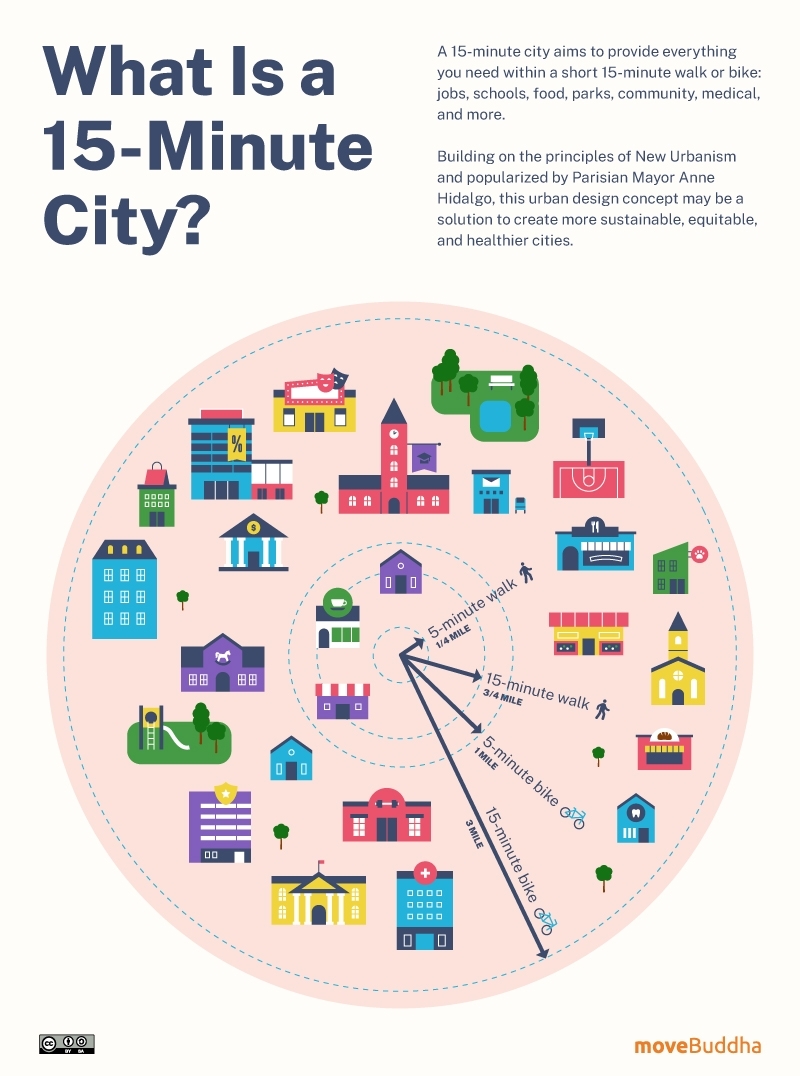15 minute cities, what are they?
What is a 15 minute City and what are it's advantages ?
In the quest for sustainable urban living, the concept of the 15-minute city has emerged as a transformative model. This innovative approach envisions cities where residents can access most of their daily needs within a 15-minute walk or bike ride from their homes. Let's delve into the key aspects that make 15-minute cities a paradigm shift in urban planning.
12 Ideas to help create 15 minute cities
1. Redesigning Urban Space:
Traditional city planning often focused on segregating residential, commercial, and recreational areas. The 15-minute city flips this model by promoting mixed-use neighborhoods. This redesign aims to create vibrant, more decentralized self-sufficient communities where work, leisure, and daily necessities coexist seamlessly.
2. Sustainable Mobility:
At the heart of the 15-minute city is the promotion of sustainable transportation. Walkability and bikeability become central to daily life, reducing dependence on cars. Accessible public transport, coupled with safe cycling lanes and pedestrian-friendly streets, encourages eco-friendly modes of commuting.
3. Localizing Essential Services:
In a 15-minute city, essential services are localized. Residents can find grocery stores, healthcare facilities, schools, and workplaces within a short distance. This not only reduces commute times but also fosters a sense of community by supporting local businesses.
4. Fostering Community Engagement:
By concentrating amenities and services in close proximity, 15-minute cities foster community engagement. Residents are more likely to participate in local events, support neighborhood initiatives, and build a stronger social fabric. This sense of community contributes to the overall well-being of the residents.
5. Health and Well-being:
Promoting an active lifestyle is a cornerstone of the 15-minute city. With amenities nearby, residents are encouraged to walk or cycle, leading to improved physical health. Additionally, reduced air pollution from minimized car usage contributes to better overall environmental health.
6. Economic Resilience:
The concept of the 15-minute city enhances economic resilience. By supporting local businesses, the community becomes less susceptible to global economic fluctuations. This decentralization of economic activity contributes to a more robust and sustainable local economy.
7. Reducing Environmental Impact:
The shift towards 15-minute cities aligns with broader environmental goals. Decreased reliance on cars and improved public transportation infrastructure help reduce carbon emissions. Compact, walkable neighborhoods also contribute to energy efficiency and lower overall environmental impact.
8. Adapting Public Spaces:
Public spaces play a crucial role in the 15-minute city. Parks, squares, and communal areas become focal points for social interaction. The emphasis on green spaces not only enhances the aesthetic appeal of the neighborhood but also contributes to mental well-being.
9. Technology Integration:
Advancements in technology play a significant role in the realization of 15-minute cities. Digital platforms facilitate local communication, making it easier for residents to stay informed about community events, share resources, and actively participate in the local decision-making process.
10. Cultural Diversity and Inclusivity:
With a focus on community engagement and local businesses, 15-minute cities embrace cultural diversity. These neighborhoods become inclusive spaces where people from various backgrounds converge, fostering a rich tapestry of experiences and perspectives.
11. Resilience Against Global Challenges:
The COVID-19 pandemic underscored the importance of resilient urban planning. The 15-minute city model, with its localized services and amenities, proved more adaptable to challenges such as lockdowns. This adaptability ensures that cities can respond more effectively to unforeseen global disruptions.
12. Revitalizing Abandoned Spaces:
In many urban areas, spaces have been neglected or abandoned. The 15-minute city model provides an opportunity to revitalize these spaces, transforming them into vibrant community hubs. Unused buildings can be repurposed for local businesses, further enhancing the character of the neighborhood.
Conclusion: Transforming Urban Living, One Neighborhood at a Time
The 15-minute city concept represents a shift towards sustainable, people-centric urban living. By prioritizing accessibility, community engagement, and environmental responsibility, these cities offer a blueprint for a more resilient and inclusive future. As cities around the world grapple with the challenges of rapid urbanization, the 15-minute city stands as a beacon of innovation, fostering a vision where urban spaces prioritize the well-being of their residents and the planet.
#technology #15minutecity #urbanliving #future #sustainability #business #transportation



































